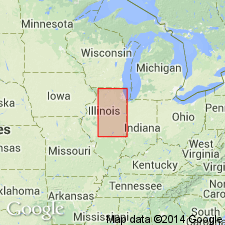
- Usage in publication:
-
- Hulick Till Member
- Modifications:
-
- Named
- Dominant lithology:
-
- Till
- Sand
- Gravel
- AAPG geologic province:
-
- Illinois basin
Summary:
Named as member of Glasford Formation (new) for Hulick School, 1.5 mi southwest of type section, which is roadcut exposure at the Lewistown Section, SW SE SE sec 21, T5N, R3E, Fulton Co, IL. Overlies the Duncan Mills (new) or Kellerville Till (new) Members. Is bounded at top by the Toulon (new), Radnor Till (new), or Berry Clay (new) Members, the Teneriffe Silt (new), or Pearl Formation (new); locally, in absence of these units, the Sangamon Soil is developed in the top of the member. Consists of till and intercalated sand and gravel outwash that is locally over 100 ft thick in Table Grove Moraine and in some deep bedrock alleys, but is more commonly about 50 ft thick. Geographic distribution in west-central IL is shown in fig 6 (Illinois basin). Spatial relations shown in fig 7. Composition given in tables 2, 4, and 5. In part of western IL, was called Buffalo Hart in previous reports (Wanless, 1957). Is in part stratigraphically equivalent to the Vandalia Till Member of south-central IL. Is within the Monican Substage of the Illinoian Stage. Till was deposited by a glacier of the Lake Michigan Lobe.
Source: GNU records (USGS DDS-6; Denver GNULEX).
For more information, please contact Nancy Stamm, Geologic Names Committee Secretary.
Asterisk (*) indicates published by U.S. Geological Survey authors.
"No current usage" (†) implies that a name has been abandoned or has fallen into disuse. Former usage and, if known, replacement name given in parentheses ( ).
Slash (/) indicates name conflicts with nomenclatural guidelines (CSN, 1933; ACSN, 1961, 1970; NACSN, 1983, 2005, 2021). May be explained within brackets ([ ]).

